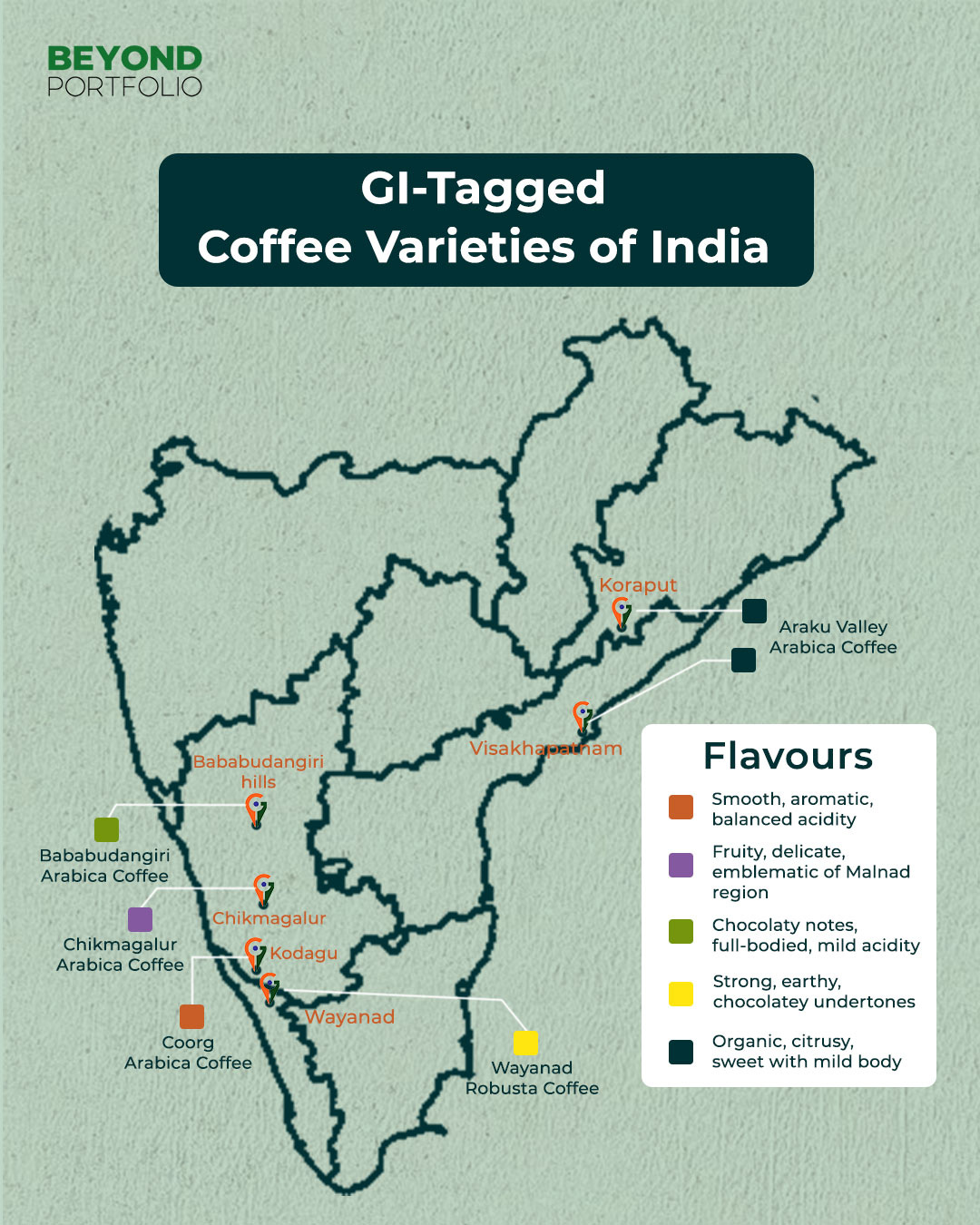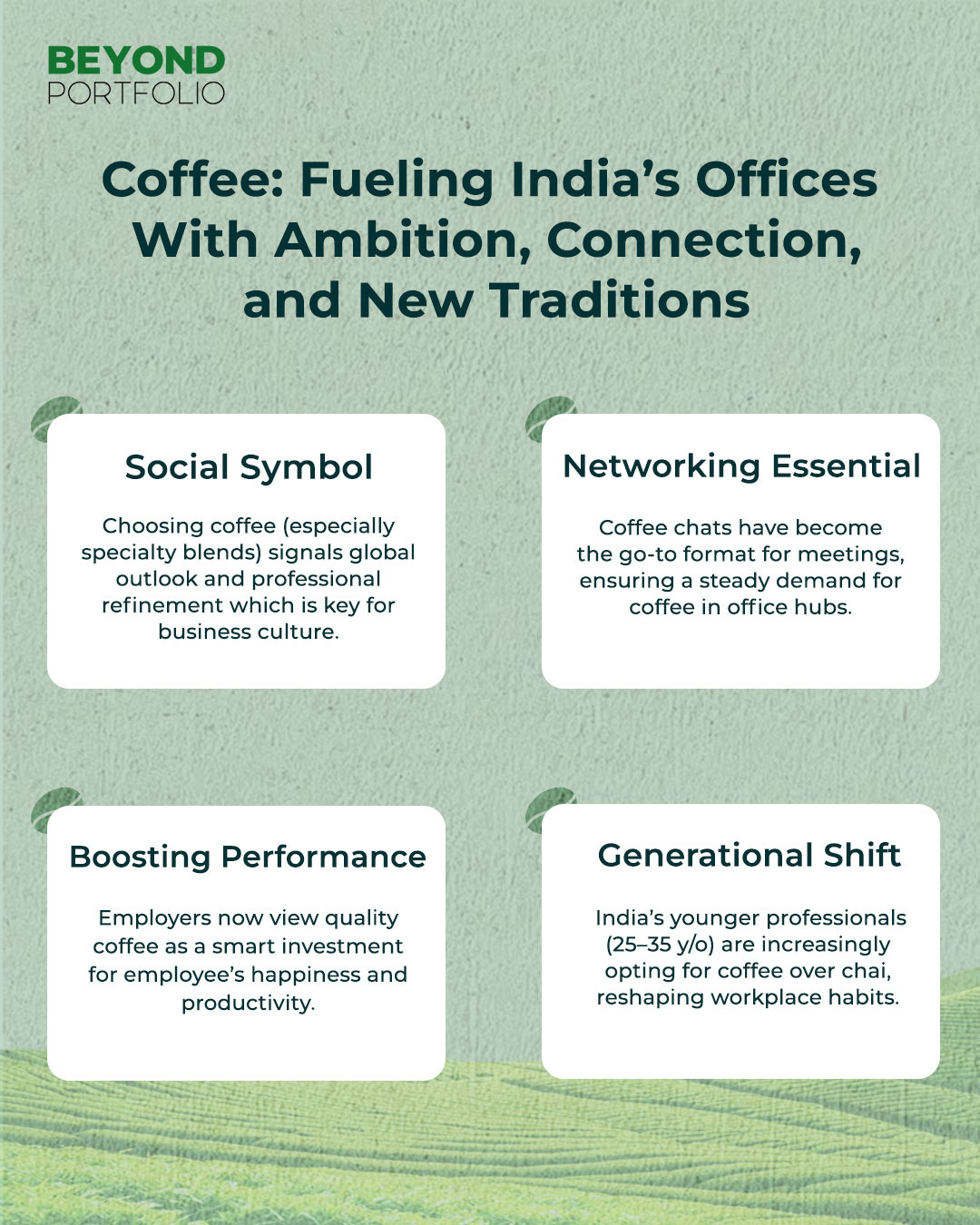From ₹2 Coffee (MASSY) to ₹890 Araku (CLASSY)
Yesterday, my coffee connoisseur friend called me up, practically buzzing with excitement, “I just spent ₹890 for 250g of Araku coffee and it's totally worth it!'"
"₹890? Our parents had coffee way less often and for just ₹2 a cup."
"Crazy, right? How did coffee become a class thing, an everyday thing, and a corporate networking thing all at once?"
"That's because India didn't just adopt coffee culture..”
India’s coffee market valued at USD 478 million in 2022, is projected to reach USD 1,227.47 million by 2032. This is driven by a compound annual growth rate (CAGR) of 9.87% over the forecast period of 2024-2033.
In a nation where chai has ruled for centuries, we're witnessing something unprecedented- coffee has become India's new national beverage.
The Indian coffee story begins in 1670.
Sufi saint Baba Budan returned from a pilgrimage to Mecca via Yemen, where he tasted coffee for the first time. Risking his life, he smuggled 7 raw coffee beans hidden in his beard, since exporting unroasted beans was strictly forbidden. He planted them in the Chandragiri Hills of Chikmagaluru, Karnataka, now called the Baba Budangiri Hills. This marked the beginning of coffee cultivation in India.
Today, India produces over 3.74 lakh metric tons annually, ranking as the 7th largest coffee producer globally.
But here's what makes it interesting, just three states control majority of India's coffee destiny: 70% of the domestically produced coffee comes from Karnataka, 23% from Kerala, and 5% from Tamil Nadu.
Moreover, India has five GI‑tagged coffee varieties. This means only coffee grown and processed within those specific regions can use their names. This makes sure that each variety’s regional identity is protected, there is no misuse of the label, and ensures that growers receive fair value for their authentic regional produce.
The certified varieties are Coorg Arabica, Chikmagalur Arabica, Bababudangiris Arabica (all from Karnataka), Wayanad Robusta (Kerala), and Araku Valley Arabica (Andhra Pradesh).
It’s fascinating to witness how the coffee trend is unfolding differently across India’s corporate hubs, each city with its unique habits and rituals rooted in their unique culture, convenience, and status.
In Gurgaon's gleaming office towers, coffee culture has become the ultimate status symbol. Walk through Cyber City during lunch hours, and you'll see executives queuing at specialty coffee shops, discussing deals over single-origin brews rather than traditional business lunches.
Bangalore, being India's Silicon Valley, has naturally embraced coffee culture. The city's tech workers treat themselves with coffee while coding. They are interested in the origin, the roasting process, and the brewing methodology. Third Wave Coffee and Blue Tokai found their strongest customer base here, where professionals appreciate the craftsmanship behind each cup.
In Noida's rapidly expanding corporate landscape, coffee represents aspiration. Young professionals use premium coffee brands to signal their arrival in the corporate world. It's become the new networking currency. "Let's grab coffee" has replaced "Let's have chai" in professional conversations.
Mumbai's relentless work culture sees coffee as efficiency optimization. Investment bankers and consultants view artisanal coffee as performance enhancement - willing to pay premium prices for better quality that keeps them sharp during long working hours.
The term “waves of coffee”, first coined by Trish Rothgeb in a 2002 article, captures three major transformations in the coffee world, that reshaped how the world drinks, thinks, and values coffee.
1st Wave (1800s - 1970s): Coffee became a mass-market product
2nd Wave (1960s - 1990s): The rise of Peet’s and Starbucks made coffee a part of lifestyle.
3rd Wave (2000s - present): Coffee was popularly recognised as a craft. Enthusiasts started demanding single-origin beans, specific roasts, and full transparency, from farm to cup.
Now, here's how India adapted this global three-wave framework to create its unique coffee story:
Wave 1: Mass Market Entry (CCD Era) that democratized coffee culture.
Cafe Coffee Day democratized coffee, making it social and accessible to middle India.
Founded by V. G. Siddhartha on July 11, 1996, in Bangalore, CCD introduced casual coffee culture to India's urban middle class with its “A lot can happen over coffee” ethos.
Expanded rapidly, over 1,000 outlets by 2011, peaking at ~1,700 across India and internationally
Wave 2: Premium Positioning (Starbucks, 2011) that brought global cafe standards.
Barista and Starbucks brought an international cafe experience. Starbucks entered India in 2012 through a joint venture with Tata.
These brands elevated consumer expectations around quality, ambience, and pricing
Wave 3: The Artisanal Renaissance that marked shift toward curated, luxury coffee experiences.
Specialty coffee, limited batches, complete brand differentiation. From a few specialty producers to almost 100 in just a few years. Coffee was not in the beverage business anymore, it was in the luxury experience business.
The specialty coffee movement began around 2013 with pioneers like Blue Tokai, now leading India’s scene with over 150 outlets and 4 roasteries
Specialty coffee now accounts for nearly 18% of the Indian market’s growth, projected to double the overall market by 2030.
India's coffee industry is booming and on a closer look these are the 4 standout features that are transforming how consumers experience coffee:
Premium Cafe Culture
The cafe culture has evolved dramatically, with Third Wave Coffee opening 43 cafes across India with plans to expand to over 150 cafes in over 20 cities. These spaces serve as social hubs where corporate employees are choosing premium coffee over free instant options, willing to pay ₹150+ for specialty lattes.
Exclusive Specialty Blends
India’s specialty coffee market is witnessing a surge in exclusive blends - crafted recipes featuring premium, single-origin beans selected from organically-certified estates. A standout example is Blue Tokai’s “Silver Oak Café Blend”, merged from estates in Karnataka and Tamil Nadu, offering hints of hazelnut, honey, and grape in every cup. Priced at about ₹540 for 250 g and alongside its “Cold Brew Bold Blend,” which retails at around ₹540 for 250 g with dark chocolate and roasted hazelnut overtones.
Complete Coffee Origin Stories
The transparency trend is driven by certified Q-graders who evaluate each batch to guarantee consistent flavor and quality. Companies practice and advertise responsible and ethical sourcing of beans while maintaining direct trade relationships with farmers. This farm-to-cup idea connects urban consumers directly with coffee growers, highlighting specific plantations and their unique terroir.
Online Home Delivery Revolution
The fourth pillar transforming India's coffee landscape is the explosive growth of direct-to-consumer (D2C) coffee delivery. During the COVID period, household consumption increased from 70% to about 90%, accelerating the shift toward home brewing.
Coffee regions worldwide - from Brazil's fazendas to Colombia's fincas and Ethiopia's highland estates, have mastered the art of agritourism. From harvesting with fifth‑generation planters to tasting sessions, India's coffee estates also prove that the most valuable crop isn’t just what grows in the soil, it’s the memories they cultivate.
Golden Wood, Sakleshpur (Karnataka)
This historic coffee estate, founded in the 1860s, spans nearly 500 acres in the Manjarabad region. Guests staying at the eco-homestay Golden Wood get to experience the “Specialty Coffee Trail”- a hands-on journey through harvesting, pulping, fermentation, roasting, and cupping, guided by the fifth generation of the Purnesh family. The estate uses solar and hydropower along with the scenic views of waterfalls and local wildlife.
The Serai, Chikmagalur (Karnataka)
Located within sprawling coffee plantations, The Serai offers guests a curated bean‑to‑cup journey: guided plantation walks, cherry picking, processing demonstrations, and tastings - all complemented by luxury hospitality, spa treatments, and nature activities. The estate blends laid-back plantation life with high-end comforts and immersive learning.
Old Kent Estates & Spa, Coorg (Karnataka)
Sitting on over 200 acres of heritage coffee, pepper, and cardamom farms, Old Kent’s "Crop to Cup" program invites guests to participate in every phase-pruning, harvesting, visiting the pulper house, and sampling coffees brewed in multiple methods, often led by international roasting specialists. This estate merges luxury lodging with lessons in plantation science and sensory appreciation.
Instead of convention centers or resorts, organizations are increasingly opting for estates such as The Tamara Coorg and Halli Berri that combine luxury lodging with immersive learning environments. These venues fuse team-building with wellness, creativity, and brand storytelling in nature-rich settings.
The result? Enhanced strategic alignment, refreshed thinking, and elevated employee engagement- all grounded in the sensory authenticity of India’s specialty coffee heritage.
So, my friend's excitement over that ₹890 Araku coffee makes perfect sense - what seems like an expensive indulgence is actually a culmination of 350+ years of Indian coffee evolution, from Baba Budan's daring act of smuggling seven beans to today's specialty coffee culture.
But what makes India's coffee story truly fascinating is how India's coffee culture isn't just mimicking international trends but it's celebrating regional terroir, supporting direct farmer relationships, by also creating immersive farm visit experiences that showcase India's unique coffee heritage.



